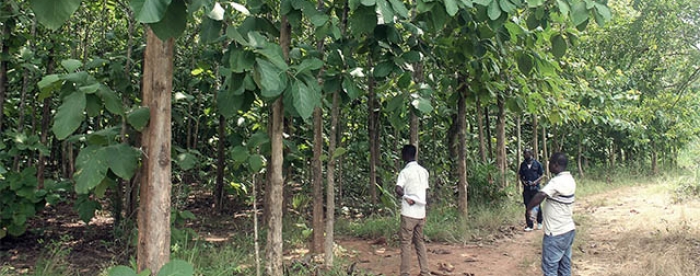News
Our stories ... ...

Ghana - 22 October, 2015
More than a decade after the Forest Plantations Development Fund (FPDF) was set up to provide various forms of assistance to plantation developers, including cash to finance their projects, a research conducted by Tropenbos International (TBI) Ghana under its Landscape Restoration Project (LRP) indicates that 68 percent of farmers are not aware of the Fund.
The fund was established in 2002 (http://www.ghanadot.com/news.gnadot.080108e.html) following the commissioning of the National Forest Plantation Development Programme (NFPDP) in September 2001 by Ghana’s then President, John Agyekum Kuffour, to support the development of a sustainable forest resource base that will meet future demand for industrial timber while providing ecosystem services to promote environmental quality, produce more food and create employment opportunities.(http://www.fcghana.org/assets/file/Publications/Forestry_Issues/National%20Forest%20Plantation%20Development%20Programme/Annual%20Reports/nfpdp_annual%20report_2005.pdf)

The results which were made available to the staff of TBI Ghana on October 13, 2015 show that only 32 percent of the farmers under study had any knowledge of the FPDF, with the Jasikan and Sogakope Forest Districts recording the lowest rate of 10 percent each, the Dunkwa Forest District recoding a rate of 28 percent while the Offinso and Sunyani Forest Districts both recorded 50 percent.
The relatively high level of awareness in the Offinso and Sunyani Forest Districts was attributed to the presence of an organised Plantation Development Association (PADO) coupled with an initial awareness creation at the inception of the project in 2002 which was neither replicated in other forest districts nor sustained.
The study observed that in general, the FPDF was associated with poor visibility and poor transparency and accountability in its financial operations. (See also the following link for more information https://www.modernghana.com/news/232783/1/minister-castigates-former-forestry-plantation-dev.html)
Furthermore, it was unable to meet the financial needs of the relatively few tree plantation farmers who applied for funding and regularly provided them with amounts far below what they had requested for which in turn proved to be a hindrance to their efforts at establishing a viable tree plantation business.
The awareness of the Modified Taungya System (MTS), one of the incentive packages being widely used by the Forestry Commission and Civil Society Organisations was however high with 100 percent of farmers in the Offinso and Sunyani Forest Districts being aware of it while 60 percent of farmers in the Jasikan and Sogakope Forest Districts were also aware of it. In contrast, only 20 percent of farmers in the Dunkwa Forest District expressed knowledge of the MTS and this was attributed to the limited number of degraded forest reserves in the area.
Benefits under the MTS, which was already being promoted before the inception of the FPDF include access to seeds and 40 percent of income accruing from tree plantations upon maturity. It is a modification of the Taungya System (TS) which was introduced in Ghana in 1928 as an incentive for tree plantation development but failed to achieve its desired goals. The MTS therefore addresses some of the shortcomings of the TS such as the forceful ejection of the farmer upon closure of the tree canopy with the management of the forest plantation reverting to the then Forestry Department.
Amongst other things, the study was also meant to assess how effective the packages have been in terms of expanding the area of smallholder plantations, improving farmers’ welfare, guaranteeing returns on farmers’ investments and sustaining farmers’ interest in plantation development.